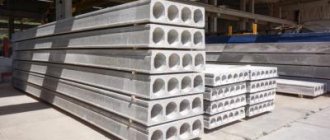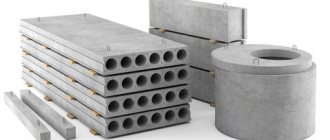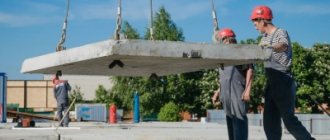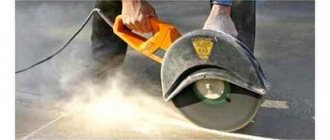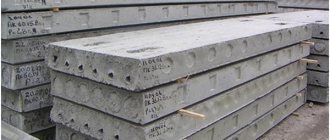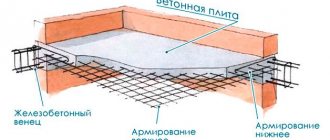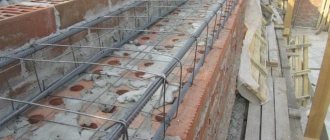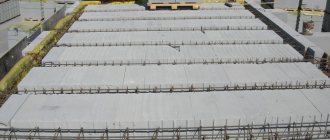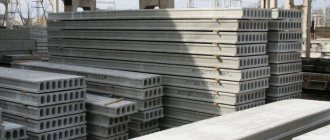Road concrete slabs (PDN)
Concrete road slabs are intended for the construction of temporary or permanent prefabricated surfaces of roads, platforms, and access roads. Areas of application: industrial and military facilities, engineering, housing, individual construction. PDN manufacturing material is concrete grade M300 or higher, steel reinforcement.
Rice. 1. Laying the road slab
1P products are intended for the construction of permanent roads, and 2P products for temporary coverings. The difference is in the concrete and reinforcement: 1P is made from B30 class concrete, and B22.5 is used to make 2P. These differences result in different load-bearing capacities.
Reinforcement is carried out in accordance with TU or GOST 21924.3-84. The differences are in the grades and diameter of the reinforcement, the location of the meshes, frames and individual rods.
Standard dimensions of road concrete slabs: height - 140-220 mm, width - 900-2750 mm, length - 1750-6000 mm, weight - 0.92-4.08 tons.
Fig.2. Road slab 1P18.18.30
Marking features reflecting geometric shape:
- PT (trapezoidal slab) - a reinforced concrete product with a flat trapezoidal surface;
- PPSh, DPSh, PShP, PShD, PSh - hexagonal-shaped products, as well as additional elements;
- P is a rectangular product, most in demand in road construction, varieties - PBB and PB, with two and one side, respectively.
The marking of rectangular products indicates the length and width in decimeters, hexagonal - diagonal, trapezoidal - length.
Where are reinforced concrete floor slabs used?
Application areas depend on the type and technical and operational characteristics of the products. However, all of them are intended for construction and are used in the arrangement of basement, interfloor and attic floors with high load-bearing capacity, and ducts of underground utility networks. The ribbed U-shaped reinforced concrete floor slab is characterized by maximum load-bearing capacity and resistance to bending loads. Therefore, it is used for arranging wide spans in industrial, commercial, and administrative facilities (factories, shopping centers, hospitals), where the requirements for aesthetic design are lower in comparison with apartment or private buildings, in the construction of which solid or hollow-core products are used.
For additional information, advice from qualified specialists and to buy concrete floor slabs at the best price, call the indicated phone numbers. Additionally, we rent special equipment and provide services for laying ready-made concrete products.
Airfield plates
The concrete airfield slab is designated by the abbreviation PAG. The products were designed for the construction of airfields, military training grounds, bridgeheads, warehouses and routes for large-capacity transport. Since these reinforced concrete products have increased wear resistance, strength and frost resistance, over time they began to be used for the construction of highways, cargo areas, and bridges.
PAG concrete slabs are manufactured in accordance with the requirements of GOST 25912-2015 and according to working drawings of technical documentation.
Main characteristics:
- concrete class for compressive strength - B30 (M350-M400), frost resistance - F200, water resistance coefficient - W6;
- design load - 75,000 kg/m2, seismic resistance - up to 7 points on the Richter scale;
- reinforcing mesh - VpI steel, reinforcing frame - non-prestressed steel of classes A-II, A-III, At-IIIC, prestressed reinforcement of classes A-IV, At-IV, At-IVC, A-V, AV.
Popular airfield concrete slabs and their features:
- PAG-14. Product length - 6000 mm, height - 140 mm, width - 2000 mm, concrete volume - 1.68 cubic meters, weight - 4.2 tons.
- PAG-18. The mass of the slab is 5.4 tons, the volume of concrete is 2.16 cubic meters. m, width - 2000 mm, length - 6000 m, height - 180 mm.
- PAG-20. The product has a height of 200 mm; 2.4 cubic meters are required to produce one slab. m of concrete. Length - 6000 mm, height - 200 mm, width - 2000 mm.
The PAG is laid on the prepared base. Installation directly on the ground is not allowed.
Rice. 3. PAG-14
Classification of concrete floor slabs
Concrete floor slabs are produced in accordance with GOST 26434-215 and are divided into multi-hollow slabs (1PK, 2PK, PB) and single-layer solid (1P and 2P). Factories also produce PNO (lightweight) and NV (without mounting loops and embedded) slabs. Multi-hollow products differ in thickness, shape and diameter of the voids, and method of support. The slab can have a thickness of 160, 220, 260 or 300 mm, the voids are round, semicircular, oval, pear-shaped. The product is intended to be supported on 2, 3 or 4 sides.
Solid floor slabs and their modifications
The PTP, TP, BZh and V slabs presented in this section are used to cover impassable channels and arrange the foundations of various reinforced concrete structures. These concrete products are produced on modern, high-tech equipment in strict accordance with current GOSTs. Solid slabs of these modifications are structurally somewhat similar to the floor slabs of canal chambers.
- PTP slabs. This abbreviation refers to a flat prestressed slab manufactured in accordance with current regulations. This modification is used to cover underground transport tunnels, as well as pedestrian crossings. PTP channel floor slabs are used in standard, non-seismically active conditions.
- Solid TP slabs differ from other modifications in their more impressive dimensions - thickness 22 cm, length from 270 to 470 cm, width from 80 to 160 cm. Their main purpose is to cover recessed channels of a fairly large cross-section. Concrete TP floor slabs are used to cover underground channels with a burial depth of up to 6 m.
- BZ channel floor slabs These products are distinguished by the most miniature dimensions for this type of product - width 40 cm, length from 60 to 130 cm and the location of the reinforcement, which determines the installation of these slabs in width.
- Solid floor slabs B are used mainly for the construction of large cross-section channels. The size range of this item is represented by numerous options in height, width and length. The reinforcement, as in the case of concrete slabs, is located in such a way that these reinforced concrete products are laid in width and not in length.
All reinforced concrete products presented in this section can be used simultaneously with other items - trays and coverings used for the construction of communications.
PC panels
Rice. 4. Floor slabs
PC concrete slabs are most often used in construction. Areas of application: construction of multi-storey buildings, buildings and structures, pitched roofs of garages and sheds, installation of protective structures for heating mains. PCs are also used as a foundation for gazebos and fences.
Through voids of semicircular, round or oval shape are located along the entire length. PC is the basic version with support on 2 sides, PKT is supported on 3 sides, PKK - on 4.
The purpose of hollow-core slabs is to construct horizontal floors in multi-storey buildings, including commercial, residential and administrative ones. Utilities are placed in the voids.
The main advantages of hollow-core concrete slabs:
- Reduced weight compared to solid concrete products. The load on load-bearing walls is lower than when using slabs without voids, which is why PCs are in demand in multi-story construction.
- Soundproofing properties. Thanks to air pockets, the slabs reduce the level of noise coming from rooms located on the floor above or below.
- Thermal insulation characteristics. Air has low thermal conductivity, so heat is better retained in a room with hollow-core floors.
Products up to 4.2 m in length are reinforced with conventional mesh, and prestressed reinforcement is used to strengthen longer products. To strengthen the ends, vertical meshes are installed along the edges.
What kind of floor slabs do we produce?
We produce solid and hollow-core concrete slabs:
- On the supporting sides - PC (two sides), PKT (three sides), PKK (four sides);
- According to the manufacturing method - PC with formwork molding, PB with formless molding on special conveyors;
- By type, profile shape - solid, multi-hollow, ribbed;
- According to the method of reinforcement - stressed and unstressed rods, metal mesh;
- According to the composition of the concrete mixture - with modifying additives and plasticizers.
Prices for concrete floor slabs depend on their type, purpose and size. The main advantage of the PB series is that we can quickly produce products of arbitrary sizes on a conveyor belt. Reinforcement is performed with steel cables during continuous molding, and the surfaces of subsequently cut concrete products are processed with special grinding devices.
Products of the PC series are manufactured using formwork, reinforced with stressed and unstressed metal rods and steel mesh, which ensures maximum strength. The load-bearing capacity is from 800 kilograms per 1 square meter. The presence of voids helps reduce weight and increase heat and sound insulation properties.
PB
Rice. 5. 1PB plate
Concrete hollow-core slabs PB are produced according to working drawings of the IZH 976 series using the method of continuous formless molding. They are provided with support only on 2 sides. Support depth - from 9 to 15 cm. Width of reinforced concrete products - 1000, 1200 1500 mm, height - 220 mm, length can be any in the range from 1 to 10.8 m. Scope of application: covering and overlapping of monolithic and brick buildings of general, civil and residential purposes.
Main characteristics:
- The material of manufacture is heavy concrete grade M400, compressive strength class B30.
- Types of formless technology used in Russia are “one-step” vibration molding, two-layer split molding, and extrusion.
- The basic design load (typical) is 800 kgf/m; upon request, it is possible to manufacture products designed for loads from 300 to 2100 kgf/m.
PB reinforced concrete slabs are reinforced longitudinally, so they can be cut both transversely and diagonally without compromising their strength characteristics.
PNO
Rice. 6. PNO plate
Lightweight PNO products are produced in accordance with GOST 9561 and the addition to the series 1.141-1, no. 39. The peculiarity of these concrete slabs is their reduced thickness, which is only 160 mm versus the standard 220 mm. The products are intended for the construction of buildings up to 3 floors high inclusive. Load-bearing capacity - from 300 to 800 kgf/m2.
Standard dimensions: length - 1600-6300 mm, width - 1000-1500 mm. The slab has through longitudinal voids, thanks to which it has increased noise and heat insulation characteristics and lower weight compared to solid products of similar dimensions. It is possible to cut the concrete slab across and at an angle.
Coating slabs (ribbed)
Concrete ribbed slabs are a wide group of products used in the construction of panel houses with a flat roof, industrial buildings and structures without an attic, and public facilities. Reinforced concrete products have auxiliary elements located longitudinally and transversely, which ensure resistance to increased bending loads.
The scope of application is limited to the creation of attic and roof floors, since due to the protruding beams it is impossible to install a flat ceiling. Precast concrete products can withstand not only significant weight loads, but also temperature changes, humidity, and prolonged exposure to chemically aggressive environments. The slab has a U-shaped cross-section and can be made with or without an opening in the shelf.
Peculiarities:
- Material - heavy, structural lightweight or dense silicate concrete. Heavy is used more often (grade M200, compressive strength class B15 or higher). According to GOST 26633, additives can be added to the mixture to increase hydrophobic protection.
- Frost resistance - not lower than F75-F100, water resistance class - W4 to W6, based on design requirements. Water absorption - up to 5% of the total mass.
- The marking consists of the following elements: abbreviated name, hole diameter (if any), length and width in decimeters, design load, reinforcement class.
Classification of floor slabs
According to GOST 26434-2015 “Reinforced concrete floor slabs for residential buildings. Types and main parameters,” manufacturers offer the following options for reinforced concrete structures for the installation of floors:
- solid single-layer (1P and 2P);
- multi-hollow (1pk, 2pk, PB).
A wide range of products is presented in GOST 9561-91 “Multi-hollow reinforced concrete floor slabs for buildings and structures. Technical conditions".
Voids of round, semicircular or oval shape are located along the length of the panel. The structures have a flat surface and are designed for high operating loads. Hollow-core reinforced concrete floor slabs have a number of advantages, including:
- cost-effectiveness in production - due to the presence of voids, less concrete is used, cement is saved;
- high noise and heat insulation performance - air layers inside the structure partially dampen sound waves and vibrations and do not transmit heat well;
- practicality - internal voids in the panels can be used for laying utilities - electrical cables, low-current wiring, air conditioning system pipes, etc.
Along with PC slabs, PKT and PKK panels are used; they differ from the basic version in the number of supporting sides, as can be seen from the table above.
When choosing materials for construction, you should take into account the thickness, length and width of the reinforced concrete floor slab.
Slab type
| Coordination slab dimensions (mm) | ||
| Length | Width | |
| 1pcs 2pcs 3pcs | From 2400 to 6600 inclusive. at intervals of 300, 7200, 7500 | 1000, 1200, 1500, 1800, 2400, 3000, 3600 |
| 1PKT | 9000 | 1000, 1200, 1500 |
| 1PKT 2PKT 3PKT | From 3600 to 6600 inclusive. at intervals of 300, 7200, 7500 | From 2400 to 3600 inclusive. at intervals of 300 |
| 1PKK 2PKK 3PKK | From 2400 to 3600 inclusive. at intervals of 300 | From 4800 to 6600 inclusive. at intervals of 300, 7200 |
| 4pcs | From 2400 to 6600 inclusive. at intervals of 300, 7200, 9000 | 1000, 1200, 1500 |
| 5pcs | 6000, 9000, 12000 | 1000, 1200, 1500 |
| 6pcs | 12000 | 1000, 1200, 1500 |
| 7pcs | From 3600 to 6300 inclusive. at intervals of 300 | 1000, 1200, 1500, 1800 |
| PG | 6000, 9000, 12000 | 1000, 1200, 1500 |
In addition to the dimensions of precast reinforced concrete floor slabs, the diameter of the voids is taken into account - the smaller this indicator, the higher the strength of the panel. Also, the maximum strength indicators (and weight) are influenced by the characteristics of the concrete (light or heavy) and the thickness of the reinforced concrete floor slab.
At the design stage of a building, it is important to pay attention to the load-bearing capacity of the panels from which it is planned to mount the ceiling. Standard hollow core slabs, which are suitable for residential construction, can withstand a load of about 800 kg/m2. For multi-storey buildings with increased loads, including industrial ones, it is preferable to choose slabs with prestressed reinforcement - they can withstand about 1200 kg/m2.
The popularity of hollow core reinforced concrete floor slabs is largely based on the large selection of slab sizes - you can almost always choose a suitable option for use within a specific project.
PB panels
The new type of hollow core slabs differs from the classic PC series in production technology and reinforcement principles. The method of continuous molding and the absence of cross-links in the reinforcement frame allows us to produce panels of any convenient length to order.
Moreover, they can be cut not only across, but also at an angle, in order to be used in buildings of an original shape. PB panels are most convenient for private developers - there is no need to adjust the project to standard sizes of floor slabs.
Ribbed panels
Ribbed reinforced concrete floor slabs have a U-shaped configuration due to longitudinal ribs on the lower surface of the slab. Due to these ribs-beams and reinforcement, the slabs are rigid and resistant to bending loads with a relatively small thickness.
In private housing construction, this series of reinforced concrete floor slabs is practically not used, since difficulties arise with the aesthetic finishing of the ceiling.
Ribbed slabs
| Product | Size(mm) | Weight (kg) | ||
| Length | Width | Height | ||
| PRTm-1 | 1170 | 390 | 90 | 65 |
| PRTm-2 | 1370 | 390 | 90 | 76 |
| PRTm-3 | 1570 | 390 | 90 | 87 |
| PRTm-4 | 1770 | 390 | 90 | 100 |
| PRTm-5 | 1970 | 390 | 120 | 128 |
| PRTm-6 | 2170 | 390 | 120 | 141 |
| PRTm-7 | 2370 | 390 | 120 | 154 |
| PRTm-8 | 2570 | 390 | 120 | 167 |
| PRTm-9 | 2770 | 390 | 120 | 180 |
| PRTm-10 | 2970 | 390 | 150 | 197 |
| PRTm-11 | 3170 | 390 | 150 | 206 |
| PRTm-12 | 3370 | 390 | 150 | 227 |
| PRTm-13 | 3570 | 390 | 150 | 240 |
Precast concrete factories produce floor slabs with stiffeners of the following height:
- 300 mm – for public buildings, for attic floors of residential buildings;
- 400 mm – for large industrial and commercial buildings.
The standard length of a reinforced concrete floor slab with ribs is 6 or 12 meters; products with a length of 18 meters can be manufactured.
Solid slabs
Panels without voids are usually used as additional elements when installing floors. Due to the absence of air layers, they do not provide heat and noise protection, but are characterized by high strength - they can withstand loads from 1000 to 3000 kg/cm2. The panels are suitable for covering storage rooms, bathrooms, and corridors.
Other types
Other types of reinforced concrete slabs: transitional, slope reinforcements, beds. They are made of heavy concrete grade M400, compressive strength class - B30, water resistance - W8, frost resistance - F200-F300.
A bench is a flat rectangular product for road construction. Purpose: interface of engineering structures with embankments and dams. At the ends, on both sides or only on one, a reinforcement outlet may be provided, designed for a strong connection with other elements.
Rice. 7. Lying down
Transition slabs generally have the same purpose as the beds, only the latter serve as the foundation. There are straight (P) and oblique (PC) products. PCs have an end slope at an angle of 50-75°; they are laid in places where a road and another structure (bridge, tunnel) form an oblique intersection.
Slope strengthening slabs - square and rectangular products. Types: P-1, P-2, P-1K, PB-1, B-8 with beveled corners. Scope of application - road construction, purpose - protecting the slopes of highway embankments from sliding, maintaining the roadway and soil base in a stationary position. To form a green slope, lattice products PR-3i are laid: after installation, the cells are covered with soil and sown with grass.
